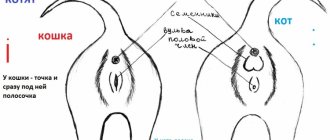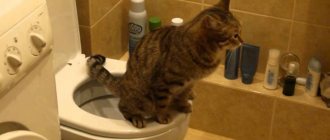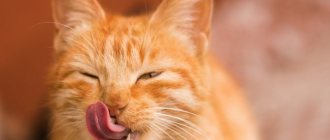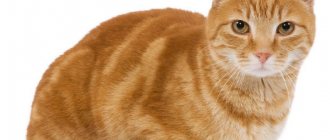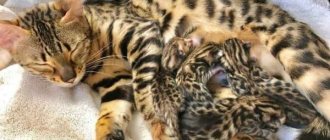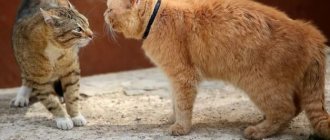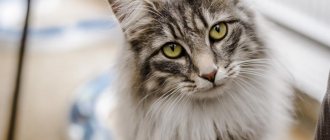The genital organs in cats are organs that produce germ cells, which excrete sexual products and are the site of fertilization and development of the embryo.
The genitals form the reproductive or reproductive system of cats.
Cats, like all mammals, have two sexes - male and female, whose genital organs are different.
Female genitals
The external genitalia are called the vulva.
It consists of two labia, connected by the dorsal and ventral commissures. The vulva is an opening at the bottom of the perineum, oriented upward. During estrus, minor changes occur to her. The vagina is an organ for copulation. It consists of two parts: back and front. Something small can be inserted into the latter, for example, probes with a diameter of 1 mm. Therefore, examining this organ is not easy. The length of a cat's vagina is on average about 4 centimeters. It is impossible to examine the uterus during a simple gynecological examination. For this purpose special devices are used.
The uterus is a short body 2 centimeters long with two branches with a diameter of 3 mm and a length of 10. Embryos are placed in them during pregnancy. At the top of each “horn” are the ovaries. After ovulation, eggs move through the fallopian tubes. There they can be fertilized. Afterwards they enter the uterus with conditions favorable for development.
A cat has five pairs of nipples, sometimes four.
Components of the skeleton
Cats are elegant and graceful, everyone knows this. These are very active animals that make a huge number of movements and can take a variety of poses due to the complex structure of the skeleton.
The cat skeleton consists of 230-240 bones, their number directly depends on the number of vertebrae. The skeleton is divided into two parts: the periphery (paws) and statics (spine and skull). The spine is also divided into sections according to the area of location. Each department is responsible for performing specific movements.
Male genitals
Sperm is produced in the seminiferous tubules of the cat's testes. They are ovoid in shape and reach a size of 1-1.5 centimeters. The tubules are convoluted balls, between which are located endocrinocytes - glands that produce male hormones. The most important among them is testosterone. It stimulates the development of the accessory sex glands and the formation of primary and secondary sexual characteristics.
It takes 2 months for sperm to form. Then they ripen in the appendages of the testes. They are narrow tubes folded many times. Their length is 2-3 meters. After maturation, sperm become motile and can fertilize.
The testes and their appendages are located in a skin sac - the scrotum.
At the moment of ejaculation, sperm is mixed with the secretions of the prostate gland. This is necessary to liquefy the seed.
During the resting period, small amounts of sperm are excreted from the body along with urine. During sexual intercourse, their mobility increases sharply. They rush into the vas deferens, and then into the urethra, where they mix with the secretions of the accessory sex glands. This is how sperm is formed.
The volume of ejaculate is 60 microliters. It varies by individual, breed and size: from 10 to 300. Semen contains from 50 to 600 million sperm.
The physiological norm in males is that germ cells enter the urine during ejaculation.
The peculiarity of the structure of a cat's penis is that it has keratinized papillae on the head. The erection pushes them forward and deflects the penis forward. The branches on the penis depend on the hormone androgen. After castration, the papillae disappear. At rest, the cat's penis points downwards.
Seasonality factors
The domestic cat is a polycyclic seasonal animal. This means that the animal's sexual activity is related to the length of daylight hours. A cat is only capable of fertilization at a certain point in the year. The sexual cycle resumes several times during this period. The dog, contrary to popular belief, is a monocyclic species: it comes into heat only twice a year, and does not depend on the time of year.
Females become capable of fertilization 1-2 months after the winter solstice. In the Northern Hemisphere - in January or February.
It is then that the hormone melatonin is produced, which controls reproduction processes. When daylight hours decrease, estrus ends. Experts call this period anestrus.
A cat's cycles begin with a drop in melatonin levels.
Artificial lighting
Changes in illumination affect animals regardless of their lifestyle. Its changes are especially felt by homeless people who do not encounter artificial light. Many kennels house animals under controlled lighting to induce estrus.
Temperature
The effects of temperature fluctuations have not yet been scientifically proven, but decreased sexual activity is often noted in animals when the temperature in the nursery becomes higher or lower than normal.
Breed Features
The sensitivity of animals depends on the breed and breeding line. In Persians, seasonality is pronounced; in Siamese and Oriental cats, estrus can be observed during short daylight hours.
If the female is nevertheless fertilized during this period, she will bear fewer offspring than in normal times.
Polygamy in cats
Cats, like most mammals, are polygamous: they can copulate with different partners, although there are occasional exceptions. The longest time when these partners can be mutually faithful is the period of one cat's heat.
Mark Walters in the book “The Dance of Life: Courtship in the Animal Kingdom” writes about his theory of the existence of polygamy: “The highly developed maternal instinct in females, aimed at feeding, caring for and raising offspring, makes polygamy more characteristic of males, i.e., the more numerous offspring, the greater the number of cubs that can survive. Less surprising is that almost all birds are monogamous, while 97 percent of all mammals are polygamous. The topic of a separate book could be a description of how male mammals take part in raising their offspring.”
Many scientists believe that polygamy leads to differences in size and shape between males and females: with polygamy, males are larger, since there is rivalry between them, they participate in mating tournaments. In monogamy, females and males are almost identical.
Many owners try to take advantage of their pets' natural tendency towards polygamy, wanting to raise a small cat so that it becomes a breeding sire. The first necessary condition for this is the creation of conditions for kittens that ensure their normal development. Kittens deprived of communication with their brothers grow up to be poor producers. The poor things have never seen it and don’t know how to do it. Another necessary condition is the presence of an experienced teacher. When the cat is one year old, he needs to be introduced to a sensitive and preferably already experienced cat. The meeting place should be familiar and convenient for the cat and subsequently be associated with a place where he can make love. If he rejects one cat, offer him another. Many cats are picky when choosing a partner.
Cat muscles.
The main function of the muscles is to provide movement to all parts of the cat's body. There are two types of muscles - striated and smooth. Smooth muscles are found in internal organs such as the intestines, stomach, and bladder. They are not controlled by the cat, functioning “independently”. Their work is automatically regulated to meet the body's needs. Striated muscles are primarily attached to the skeleton. All their movements are under the conscious control of the animal. They provide movement of all parts of the body, allowing for actions such as walking, eating, wagging the tail, turning the eyes, etc.
Largest muscles of a cat
Brain and endocrine system
Anatomically, a cat's brain is similar to the brain of any mammal.
The structure of a cat's brain is similar to that of any mammal.
Different parts of the brain are responsible for one or another function in the body:
- the parietal lobe processes information received through the senses;
- the large brain is responsible for consciousness;
- the corpus callosum connects the right and left hemispheres;
- the frontal lobe is responsible for voluntary movements;
- the olfactory bulb is responsible for the perception of smells;
- the hypothalamus secretes hormones and controls the autonomic nervous system;
- the pituitary gland coordinates and controls the work of other glands;
- the spinal cord transmits information from the brain to the body;
- the pineal gland is responsible for sleep and wakefulness;
- the cerebellum controls movements and muscle function;
- the temporal lobe is responsible for behavior and memory;
- The occipital lobe receives visual and tactile signals.
The endocrine system influences the basic functions that occur in the body with the help of hormones. Most hormones are secreted by the pituitary gland and hypothalamus. Also some of them are produced by the thyroid gland, adrenal glands, ovaries in cats and testicles in cats.
The endocrine system influences the body's basic functions
Limb structure
There are two sections in the skeleton of a cat’s limbs:
A belt of the forelimbs (shoulder), the peculiarity of which is the elastic fastening of the limbs, which is necessary for cats for safe jumping and comfortable landing. It is represented by the scapula, humerus, radius and ulna (forming the forearm), and the hand. The latter consists of the wrist, metacarpus and phalanges of the fingers, of which there are only 5 on the forelimbs.
Another unique feature of feline anatomy is the absence of a full collarbone. It is represented by two non-functional bones that are not attached to the shoulder joint, but are located freely inside the muscles. The shoulder blades are attached to the spine by muscles, ligaments and tendons, due to which the shoulders have virtually no restrictions in movement.
Interesting! Due to the unique structure of the collarbone, a cat is able to crawl into even the narrowest holes if the animal’s head fits in, since it is the latter that is the most voluminous, but not subject to deformation, part of the body.
The girdle of the hind limbs, which, unlike the shoulder girdle, is rigidly and motionlessly attached to the sacrum. It includes: the pelvic and femur bones, the kneecap, the tibia and fibula, the tarsal and metatarsal bones, to which the phalanges of the fingers are attached. The pelvic bones of the hind legs are longer and better developed compared to the front legs, and the metatarsal bones are more massive, which is associated with the characteristics of the animal’s movement (in particular, jumping). Due to this structure of their limbs, cats can move quickly in horizontal and vertical planes, which is why they are excellent tree climbers. The hind legs rest on the phalanges of the 4 toes. Like other mammals, cats' elbows bend backward and knees bend forward. That part of the paw that can be mistaken for a knee bent back is actually the heel, and the true knee is located in the lower abdomen of the animal.
What is the role and what bones does each section consist of?
The cat's cervical skeleton consists of seven large vertebrae. It performs the function of supporting the head. Of course, both muscles and tendons help cope with this function. But what's amazing is that each part has movable joints, which allows the cat to freely move its head 180 degrees. Such freedom is also possible because the cat’s collarbone is not formed: it is small and not attached to the skeleton.
The conical chest consists of 13 vertebrae. Ribs are attached to them. An amazing feature of a cat’s physiology is its “false” ribs. The third part of the ribs is not attached to the thoracic vertebra at all. This phenomenon is common in all cats and is what allows the skeleton to be so flexible.
shutterstock
The lumbar region consists of the largest vertebrae, there are 7 of them, and the closer they are to the tail, the larger they are. The anatomy of a cat's skeleton is surprising in that the bones of its skeleton are especially dense. But this does not prevent them from being plastic. Why? Cartilaginous intervertebral pads provide elasticity of the joints and give the cat a huge advantage in movement.
Each vertebra has processes. It is to them that the muscles are attached. Muscles, ligaments and tendons play a huge role. They hold all the internal organs of the sternum. In addition, the front legs do not have a strong bone connection with the skeleton. They are connected by tendons and muscles. A cat's limbs are also unique. The front paws, due to the peculiarities of their anatomical structure, can turn at an unimaginable angle.
The caudal region of different cat breeds may differ in the number of vertebrae. We can only name two extreme numbers: 19 (Maine Coons) and 28 (mostly for all other breeds). The tail for a cat is of great importance:
- Movement coordination;
- Sense of balance;
- "Communicative" functions.
It is thanks to this part of the skeleton. The cat falls on its paws, walks along the edge of thin planes, and is agile in jumping. But every pet owner knows that the tail will always “tell” about the desires and mood of the cat.
shutterstock
